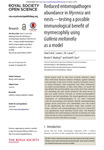Please use this identifier to cite or link to this item:
http://lib.hpu.edu.vn/handle/123456789/23544Full metadata record
| DC Field | Value | Language |
|---|---|---|
| dc.contributor.author | Larsen, Louise L. M. | en_US |
| dc.contributor.author | Meyling, Nicolai V. | en_US |
| dc.contributor.author | Schär, Sämi | en_US |
| dc.date.accessioned | 2016-10-11T05:37:11Z | |
| dc.date.available | 2016-10-11T05:37:11Z | |
| dc.date.issued | 2015 | en_US |
| dc.identifier.other | HPU4160655 | en_US |
| dc.identifier.uri | https://lib.hpu.edu.vn/handle/123456789/23544 | en_US |
| dc.description.abstract | Social insects such as ants have evolved collective rather than individual immune defence strategies against diseases and parasites at the level of their societies (colonies), known as social immunity. Ants frequently host other arthropods, so-called myrmecophiles, in their nests. Here, we tested the hypothesis that myrmecophily may partly arise from selection for exploiting the ants’ social immunity. We used larvae of the wax moth Galleria mellonellaas ‘model myrmecophiles’ (baits) to test this hypothesis. We found significantly reduced abundance of entomopathogens in ant nests compared with the surrounding environment. | en_US |
| dc.format.extent | 8 p. | en_US |
| dc.format.mimetype | application/pdf | en_US |
| dc.language.iso | en | en_US |
| dc.subject | Biology | en_US |
| dc.subject | Evolution | en_US |
| dc.subject | Symbiosis | en_US |
| dc.subject | Immunocompetence | en_US |
| dc.subject | Hygiene | en_US |
| dc.title | Reduced entomopathogen abundance in Myrmicaant nests | en_US |
| dc.type | Article | en_US |
| dc.size | 415KB | en_US |
| dc.department | Education | en_US |
| Appears in Collections: | Education | |
Files in This Item:
| File | Description | Size | Format | |
|---|---|---|---|---|
| 0538_Reducedentomopathogenabundance.pdf Restricted Access | 415.59 kB | Adobe PDF |  View/Open Request a copy |
Items in DSpace are protected by copyright, with all rights reserved, unless otherwise indicated.
